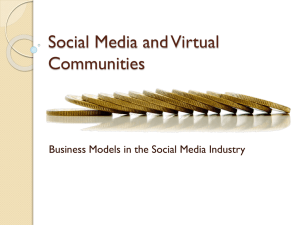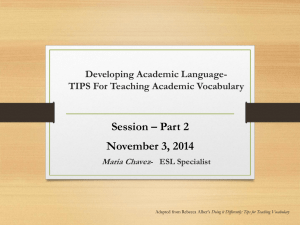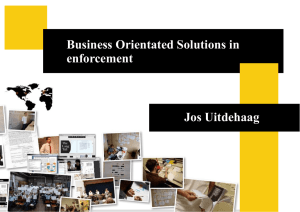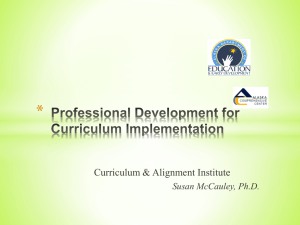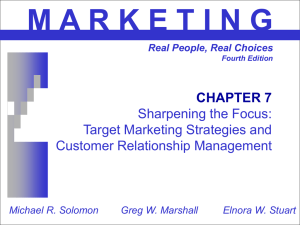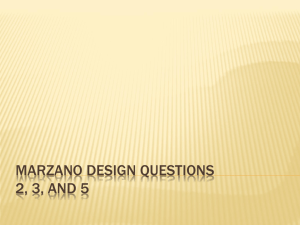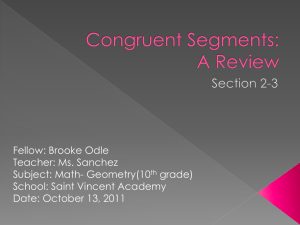What will I do to help students effectively interact with new knowledge?
advertisement
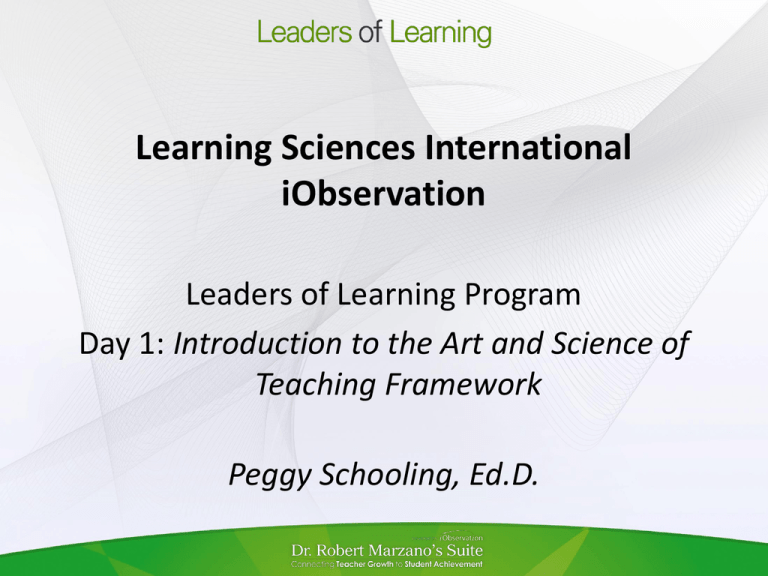
Learning Sciences International iObservation Leaders of Learning Program Day 1: Introduction to the Art and Science of Teaching Framework Peggy Schooling, Ed.D. Welcome and Introduction • Introduction • Materials and Resources You Should Have: – Participant Notebooks – Highlighter Pens – Placemat Opening Activity: Just Like Me Directions: Each time you hear a statement that pertains to you raise your hand or say “Just Like Me” You may raise your hand more than once! 3 Learning Goals • To gain knowledge about The Art and Science of Teaching as an instructional framework • To become familiar with three types of lesson segments • To learn and practice the use of strategies in lesson segments addressing content Key Vocabulary • Lesson Segment • Instructional Framework • Common Language Hopes for Our Work Today… • What are your personal learning goals for today’s session? Organizing Groups for Processing Information •Clock Partners Working Agreement • • • • • Be present: minds and hands-on all day. Use electronics respectfully. Respect time boundaries. Recognize the need for quiet while working. Complete the survey at the end of the session. 8 Working Agreement Observation and walkthrough feedback must accurately reflect the complexity of the teaching/learning process. A System of Feedback Self Observation • Teachers analyze their own teaching through videotapes Self Reflection • Teachers reflect upon their practice Instructional Rounds • Teacher and administrator teams engage collectively in examining a model or language of instruction Observations • Observation of an entire lesson Walkthroughs Common and Comprehensive Model of Instruction • Identify trends and patterns across classrooms, grade levels, schools and district “While the reasoned use of specific instructional strategies is certainly a necessary ingredient of expertise, the ultimate criterion for expert performance in the classroom is student achievement. Anything else misses the point.” Dr. Robert Marzano, On Excellence in Teaching (2009) Elbow Partners I agree……… This makes me wonder about……. The implications for the classroom are… Setting the Record Straight • Read the article Setting the Record Straight on HighYield Strategies. • Highlight what stands out for you. • Individually reflect on the following: 3-2-1 •In your notebook, record the following 3 Recalls from the Text 2 Insights Gained 1 Burning Question •Share with your group •Identify one burning question that the group would like to have answered • Record on a post it and place on the chart paper. Research shows that district leadership that focuses on student achievement and instruction can increase student achievement gains by almost 10 percentile points across the district. --District Leadership That Works: Striking the Right Balance (Marzano and Waters, 2009) 1. 2. 3. 4. MY GOALS: Our goal is to bridge this gap and move toward shared practices. The Art & Science of Teaching is designed as a comprehensive framework that puts together other works into a unified whole. The Art and Science of Teaching involves 10 “design questions” teachers ask of themselves as they plan a unit of instruction. Design Questions 1. What will I do to establish and communicate learning goals, track student progress, and celebrate success? 2. What will I do to help students effectively interact with new knowledge? 3. What will I do to help students practice and deepen their understanding of new knowledge? 4. What will I do to help students generate and test new hypotheses about new knowledge? 5. What will I do to engage students? 6. What will I do to establish or maintain classroom rules and procedures? 7. What will I do to recognize and acknowledge adherence to or lack of adherence to rules and procedures? 8. What will I do to establish and maintain effective relationships with students? 9. What will I do to communicate high expectations for all students? 10. What will I do to develop effective lessons organized into a cohesive unit? Design Questions • Form 3 groups: Elementary, Middle, and High School. Convene • In your group, count off by 3’s: – 1’s consider questions 2, 3, and 4 – 2’s consider questions 1 and 6 – 3’s consider questions 5 ,7, 8, and 9 • Consider a set of design questions and respond to the following prompt: Convene – What have you seen teachers do to address each of your questions in their classrooms? The Marzano Protocol organizes design questions into three types of lesson segments: Lesson Segments Involving Routine Events Lesson Segments Addressing Content Lesson Segments Enacted on the Spot Design Question 1: What will I do to establish and communicate learning goals, track student progress, and celebrate success? Design Question 2: What will I do to help students effectively interact with the new knowledge? Design Question 5: What will I do to engage students? Design Question 6: What will I do to establish or maintain classroom rules and procedures? Design Question 3: What will I do to help students practice and deepen their understanding of new knowledge? Design Question 7: What will I do to recognize and acknowledge adherence to or lack of adherence to rules and procedures? Design Question 4: What will I do to help students generate and test hypotheses about new knowledge? Design Question 8: What will I do to establish and maintain effective relationships with students? Design Question 9: What will I do to communicate high expectations for all students? The Marzano Protocol organizes design questions into three types of lesson segments: CONTENT-SPECIFIC SEGMENTS Interacting with New Knowledge Practicing and Deepening Generating /Testing Hypotheses The Marzano Protocol organizes design questions into three types of lesson segments: ROUTINE SEGMENTS Learning Goals and Feedback Rules and Procedures CONTENT-SPECIFIC SEGMENTS Interacting with New Knowledge Practicing and Deepening Generating /Testing Hypotheses The Marzano Protocol organizes design questions into three types of lesson segments: SEGMENTS ENACTED ON THE SPOT Teacher/ Student Relationships ROUTINE SEGMENTS Learning Goals and Feedback Rules and Procedures CONTENT-SPECIFIC SEGMENTS Interacting with New Knowledge Practicing and Deepening High Expectations Generating /Testing Hypotheses Adherence to Rules and Procedures Student Engagement The Marzano Protocol organizes design questions into three types of lesson segments: Lesson Segments Addressing Content Design Question 2: What will I do to help students effectively interact with the new knowledge? Design Question 3: What will I do to help students practice and deepen their understanding of new knowledge? Design Question 4: What will I do to help students generate and test hypotheses about new knowledge? Design Question 2: What will I do to help students effectively interact with the new knowledge? • Identifying Critical Information • Organizing Students to Interact with New Knowledge • Previewing New Content • Chunking Content into “Digestible Bites” • Processing New Information • Elaborating on New Information • Recording and Representing Knowledge • Reflecting on Learning Learning requires multiple exposures to and complex interactions with knowledge. •Identifying Critical Information — A unit with two learning goals might have four to six critical input experiences. — Adequate time must be given to ensure students process the content deeply. Examples: • Read a specific passage of text. • Watch a video. • Listen to a mini-lecture. • Watch a demonstration. • Participate in a simulation. • Organizing Students to Interact with New Knowledge — — — — — — Provides multiple reference points Challenges students to articulate their thinking Allows students to see how others process information Allows students to react to how others process information Groups of two to five Teach norms in advance. • Be willing to add your perspective to any discussion. • Respect opinions of other people. • Make sure you understand the contributions of others by asking questions. • Be willing to answer questions that others ask about your ideas. • Previewing New Content Examples: • What do you think you know? (KWL) • Overt linkages (cues) • Preview questions (questions) • Teacher summary (advance organizer) • Skimming (advance organizer) • Teacher-prepared notes (notes) Classroom Instruction that Works (2004) Clock Partner 12:00 What steps do your teachers take to: • identify critical information •preview new content? • Chunking Content into “Digestible Bites” “Learning proceeds more efficiently if students receive information in small chunks that are processed immediately. The more students know about the content, the larger the chunks can be.” The Art and Science of Teaching (2007) •Chunking Content (cont’d) Examples: • Identifying strategic stopping points during a demonstration • Asking students to briefly summarize information after each small chunk. • Eliciting predictions about what might be presented next • Think Alouds • Reciprocal Teaching • Jigsaws • Concept Attainment Clock Partner 3:00 How do you teachers “chunk” new content into digestible bites for students? How are they designing opportunities to process these chunks? • Elaborating on New Information Elaborative questions can be organized into two broad categories: Inferential Questions and Elaborative Interrogations Inferential Questions Elaborative Interrogations •Beginning with simple inferential questions, then asking the students to justify their thinking. •Asking students questions that require them to go beyond what was presented. The Art and Science of Teaching (2007) • Recording and Representing Knowledge Students record their solutions in linguistic and nonlinguistic formats. Examples: • Notes • Graphic Organizers • Dramatic Enactments • Mnemonic Devices Employing Imagery • Academic Notebooks Mental Pictures Link Strategy Familiar Place Framework Number/key word Physical Representations Dioramas Mobiles Models Manipulative 3-D maps Kinesthetic Representations Language-based hand signals Using body to create images Role Plays Five Finger Retell Using sand Musical movement Reader’s theatre Charades Skywriting Graphic Organizers Time sequence Descriptive pattern Cause/effect pattern Generalization pattern Concept pattern Episode pattern Problem Solution Pattern Web Fishbone Sorting Tree Tree Map Box and Whisker Graph Circle Map Time Line Continuum Story Map Venn Diagram Stem and Leaf KWL Chart Two or Three Column Chart Analogy chart Main idea/Supporting Details Flow Chart Combination Notes Notes Symbol, Picture or Graphic Summary Plant Reproduction Plants and animals have life cycles— growth, reproduction, and death. Reproduction can happen with seeds or without; when there are no seeds, there are spores. With seeds—conifers and flowering plants. Plant Reproduction Conifers Conifers have two cones; male contains pollen, female has ovules. When the pollen fertilizes the ovules, they become seeds. Seeds have a new plant embryo. Flowering plants Pollen pollen Male Cone Summary: Without seeds; with spores With seeds ovule Female Cone Seed Notes for Younger Children My Notes Pictures Questions Concept Map What is it like? What is it? A place where animals can thrive. There is enough space for survival. There is protection from the weather. HABITAT The animal fits within the natural food chain. Forest Lake Cave What are some examples? Clock Partners 6:00 What opportunities do your teachers provide their students to represent their understanding of new content? • Reflecting on Learning The final step to actively processing information is to have students reflect on their experiences at the end of a critical input experience. Examples: • • • • What was I right about? What was I wrong about? How confident am I about what I have learned? What did I do well during the experience and what could I have done better? Clock Partner 9:00 How have you seen teachers ask students to reflect on their learning? What do they do with the data collected from these reflections? Design Question 2: What will I do to help students effectively interact with the new knowledge? • Identifying Critical Information • Organizing Students to Interact with New Knowledge • Previewing New Content • Chunking Content into “Digestible Bites” • Processing New Information • Elaborating on New Information • Recording and Representing Knowledge • Reflecting on Learning Strategy Review Convene Individually Table • Form a group of four. • Choose a facilitator. • Review two categories of strategies on the strategy document. • Summarize your findings. • Share summaries and examples from practice in your group. Final Reflection of Design Question #2: What will I do to help students effectively interact with new knowledge? Individually • Reflect on your learning. — How could you encourage students to elaborate on new content? — When should students begin to take notes? — How can students demonstrate content understanding in their notes? — How do you give students opportunities to reflect on their learning in your setting? Table • Share your thoughts with your table group. The Marzano Protocol organizes design questions into three types of lesson segments: Lesson Segments Addressing Content Design Question 2: What will I do to help students effectively interact with the new knowledge? Design Question 3: What will I do to help students practice and deepen their understanding of new knowledge? Design Question 4: What will I do to help students generate and test hypotheses about new knowledge? Practice and Deepen New Knowledge • New learning is forged through repeated exposures to knowledge. • Exposure involves practice and knowledge deepening activities Design Question 3: What will I do to help students practice and deepen their understanding of new knowledge? • Reviewing Content • Examining Similarities and Differences • Examining Errors in Reasoning • Practicing Skills, Strategies, and Processes • Organizing Students to Practice and Deepen Knowledge • Using Homework • Revising Knowledge Design Question 3: What will I do to help students practice and deepen their understanding of new knowledge? Knowledge can be categorized as Declarative or Procedural. Declarative Knowledge •Information Procedural Knowledge •Skills/Processes Design Question 3: What will I do to help students practice and deepen their understanding of new knowledge? Declarative Multiple Exposures Deepening Understanding Procedural Practice & Feedback Fluency Concept Attainment Declarative Procedural • Understands that words and pictures convey ideas or meaning in a text • • Understands that animals have characteristics that help them adapt to their environment • Knows the causes and effects of the American Revolution • • Knows the rules that govern various sports • • Understands the concept of mutation • Knows vocabulary terms: tourism, urban, rural, plateau • • • Solves multi-step problems involving fractions, decimals, and basic percents. Use prewriting strategies to plan written work. Predicts possible results of scientific investigations. Summarizes information found in texts. Prepares a slide for biology. Follows steps in a recipe Table Talk Why is it important to distinguish between declarative and procedural information? • Examining Similarities and Differences There are four basic types of tasks that focus on identifying similarities and differences. Examples: • Comparing • Classifying • Creating metaphors • Creating analogies Comparison Matrix Characteristics Three Little Pigs Characters Little Red Riding Hood Jack and the Bean Stalk Comparisons Similarities Differences Setting Similarities Differences Plot Similarities Differences Theme Similarities Differences What did you discover? Fractions and Decimals are similar because they both: ________________. ________________. ________________. Fractions and Decimals are different because: Fractions ______, but Decimals ________. Fractions ______, but Decimals ________. Fractions ______, but Decimals ________. A monarchy and a dictatorship are similar because they both: ________________. ________________. ________________. A monarchy and a dictatorship are different because: a monarchy____, but a dictatorship____. a monarchy____, but a dictatorship____. a monarchy____, but a dictatorship____. Table Talk How do teachers in your setting provide opportunities for students to: •Compare •Classify •Create metaphors •Create analogies • Examining Errors in Thinking Analyzing errors is a powerful way to deepen student understanding of declarative knowledge. Examples: • Faulty logic • Attacks • Weak reference • Misinformation Questions that Help Students Identify Errors in Thinking Analyzing Errors Analyzing Perspectives Constructing Support • What are the errors in reasoning in this information? • How is this information misleading? • How could it be corrected or improved? • Why would someone consider this to be good, bad or neutral? • What is the reasoning behind his or her perspective? • What is an alternative perspective and the reasoning behind it? • What is an argument that would support the following claim? • What are some of the limitations of this argument or the assumptions underlying it? Classroom Instruction that Works (2004) Framework for Supporting a Claim Grounds • Once a claim is made, it should be supported with grounds (e.g., matters of common knowledge, expert opinion, experimental evidence, other information considered factual). Backing • Establish the validity of the grounds and elaborate on them. Qualifiers • Express the degree of certainty and/or exceptions to the claim. Table Talk Describe how you have seen teachers provide opportunity to identify errors in thinking in your setting? How does this practice effect student learning? • Practicing Skills, Strategies, and Processes Effective practice transforms mechanical procedural knowledge to fluent procedural knowledge. Examples: • Solves multistep problems involving fractions, decimals, and basic percents • Uses prewriting strategies to plan written work • Predicts possible results of scientific investigations • Summarizes information found in texts • Prepares a slide for biology • Follows steps in a recipe Progression of Practice • Initially provide structured practice sessions spaced close together. • Provide practice sessions that are gradually less structured and more varied. • When appropriate, provide practice sessions that help develop fluency. Massed vs. Distributed Practice Massed Practice Distributed Practice Find someone you have not talked with today Describe the ways teachers design practice opportunities for students in your setting? Do you see more massed or distributed practices? • Organizing Students to Practice and Deepen Knowledge Cooperative learning techniques can be used in a wide variety of instructional situations. — Small groups can work with declarative knowledge at any time (e.g., comparison, classification, metaphors and analogies, and identifying errors). — For procedural knowledge, independent practice should occur first. Small groups focus on checking accuracy and sharing each learner’s approach. Table Talk How do teachers use cooperative structures in your setting? What is the impact on student understanding when cooperative structures are used effectively? Why? • Using Homework “When seven classes worth of homework is piled on us nightly, we’re up ‘til 12 studying for things that, at that hour, don’t even make sense. In the morning, we stumble into class, sometimes unshowered, and then the teacher complains. Let’s think about this: We do homework but get nothing out of it - then we get into trouble, plus we stink. To me, there’s no benefit here.” Katie Marland (age 15) Prairie Village, Kansas The Homework Ate My Family KIDS ARE DAZED, PARENTS ARE STRESSED BY ROMESH RATNESAR Purposeful Homework • Homework that helps students deepen their knowledge (declarative) • Homework that enhances students’ fluency with procedural knowledge • Homework that introduces new content Example of Homework that Helps Prepare for New Learning Mr. Berken wanted his biology class to understand that ecosystems are interdependent. Before he began the unit, he asked students to create a graphic organizer for homework that depicted the knowledge they already had about various ecosystems and their relationships to each other. He then used these organizers as a means to help inform him as to what additional information students would need to learn. Find someone who you haven’t spoken with today Do you have a homework policy in your school or district? If so is the focus on time spent or quality of task? Reflection Activity: Deepening Understanding and Practice What was new? What am I sure about? What do I still have questions about? Design Question 3: What will I do to help students practice and deepen their understanding of new knowledge? • Reviewing Content • Examining Similarities and Differences • Examining Errors in Reasoning • Practicing Skills, Strategies, and Processes • Organizing Students to Practice and Deepen Knowledge • Using Homework • Revising Knowledge The Marzano Protocol organizes design questions into three types of lesson segments: Lesson Segments Addressing Content Design Question 2: What will I do to help students effectively interact with the new knowledge? Design Question 3: What will I do to help students practice and deepen their understanding of new knowledge? Design Question 4: What will I do to help students generate and test hypotheses about new knowledge? Generating and Testing Hypothesis about New Knowledge • Tasks that require students to question their knowledge • Tasks in which students are required to experiment with new knowledge What happens when you’re not prepared to apply new knowledge? Video Clip Design Question 4: What will I do to help students generate and test hypotheses about new knowledge? • Organizing Students for Cognitively Complex Tasks • Engaging Students in Cognitively Complex Tasks Involving Hypothesis Generation and Testing • Providing Resources and Guidance • Organizing Students for Cognitively Complex Tasks Grouping students for cognitively complex tasks is not a random act, it must be intentional to be effective. Students can be grouped in a variety of ways, the intent is to maximize the learning potential by grouping students for success. For example: • Interest • Learning Style • Presentation Choice • Ability/Skill Level • Engaging Students in Cognitively Complex Tasks Involving Hypothesis Generation and Testing Problem Solving • The process of overcoming constraints or limiting Decision Making • The process of generating and applying criteria to select Historical Investigation Experimental Inquiry conditions that are in the way of pursuing goals. from among seemingly equal alternatives. • The process of identifying and resolving issues about past events about which there are confusions or contradictions. • The process of generating and testing explanations of observed phenomena. Problem Solving 1. Identify the goal you are trying to accomplish. 2. Describe the barriers or constraints that are preventing you from achieving your goal—that are creating the problem. 3. Identify different solutions for overcoming the barriers or constraints and hypothesize which solution is likely to be the most effective. 4. Try your solution —either in reality or through a simulation. 5. Explain whether your hypothesis was correct. Determine if you want to test another hypothesis, using a different solution. Decision Making 1. 2. 3. 4. 5. 6. Describe the decision you are making and the alternatives you are considering. Identify the criteria that will influence the selection, and indicate the relative importance of the criteria by assigning an importance score from a designated scale (e.g., 1-4). Identify different solutions for overcoming the barriers or constraints and hypothesize which solution is likely to be the most effective. Rate each alternative on a designated scale (e.g., 1-4) to indicate the extent to which each alternative meets each criterion. For each alternative, multiply the importance score and the rating and then add the products to assign a score for the alternative. Examine the score to determine the alternative with the highest score. Based on your reaction to the selected alternative, determine if you need to change any importance scores or add or drop criteria. Decision Making 1. Identify a decision you wish to make and the alternatives you are considering. 2. Identify the criteria you consider important. 3. Assign each criterion an importance score. 4. Determine the extent to which each alternative possesses each criterion. 5. Multiply the criterion scores by the alternative scores to determine which alternative has the highest total points. 6. Based on your reaction to the selected alternative, determine if you want to change importance scores or add or drop criteria. Criteri a Importance Scores Decision-Making Matrix Alternatives Used Honda Cost MPG Roomy Safety Style 4 2 2 4 1 Jetta Durango Lexus 350 4x 4x 4x 4x 2x 2x 2x 2x 2x 2x 2x 2x 4x 4x 4x 4x 1x 1x 1x 1x Decision Making (cont’d) • 2010--you are on the board of Time magazine. For the cover of the December issue, your want to select a “Person of the Decade.” Your job is to decide which person should be selected and then justify your decision to the publishers by listing the people who were considered, the criteria you used, and how each person was rated under each criterion. Report on… •The criteria you used and the importance you placed on each. •The individuals you considered and the extent to which they met your criteria. •Your final selection. Table Talk Describe a decision making activity you have seen implemented in your setting. How did this task enable students to generate and test hypotheses about new content? How did this learning experience effect students’ depth of understanding of content? Historical Investigation • Select a major movement from the 60s that involved civil disobedience. Consider what would have happened if there had been no civil disobedience as part of the movement. Identify a different method of seeking change. Report on… • How the movement during the decade might have played out differently. • How the present would be different. • If there had been no civil disobedience and, instead, the method of change you identify had been used exclusively. Turn & Talk Describe an historical investigation that impacted student learning in your setting. • Be very specific so your partner can picture the learning experience you are describing. Experimental Inquiry 1. Observe something that interests you and describe what has occurred. 2. Explain what you have observed. What theories or rules could explain what you have observed? 3. Based on your explanation- make a prediction. 4. Set up an experiment or activity to test your prediction. 5. Explain the results of your experiment in light of your explanation. If necessary, revise your explanation or prediction or conduct another experiment. Experimental Inquiry WOODSTOCK • People who were in high school and college during the 1960s are now in their 50s and 60s. Consider this population. Some would say that it is interesting that there seems to be no lasting effect of the 60s on these people. One possible explanation for this is that the effect is there, but it is very subtle. Try to determine what effects the experiences of the 60s are having on the lives of these people now. Test your hypothesis and report on… Experimental Inquiry • Fluffy Eggs – You are a young chef charged with preparing a birthday breakfast for a family member – You are wondering how to create the fluffiest eggs for this meal. – Design an experiment that will help you compare the fluffiness of eggs using 3 different preparation methods (low fat milk, water, cream). Report on… • Your hypothesis and how you tested your hypothesis. • Your findings. • Your conclusions. • Providing Resources and Guidance – Design questions 2,3, and 4 represent a progression from teacher centered to student centered learning experiences. – In deciding how to help students generate and test hypotheses about new content, teachers need to design a coaching role for themselves and working role for students. – Resources needed for students to be successful on tasks need to be carefully considered ahead of time. Key Points • Don’t just expect the thinking, teach the thinking. • Students are more likely to deepen understanding when engaged in thinking beyond recall. • Just asking high level questions is not enough. • Teach specific processes and then help students apply those to content knowledge. • Aim for long term retention and use of knowledge Reflection Activity: Key Points • What are the implications of the key points to creating effective learning experiences for students in your setting? Design Question 4: What will I do to help students generate and test hypotheses about new knowledge? • Organizing Students for Cognitively Complex Tasks • Engaging Students in Cognitively Complex Tasks Involving Hypothesis Generation and Testing • Providing Resources and Guidance Final Reflection of Design Question #4: What will I do to help students generate and test hypotheses about new knowledge? • Individually respond to the following reflection questions, then share your responses with your table group. — How often are students in your school offered the opportunity to generate and test hypotheses? — In what curricular areas do students regularly have the opportunity to generate and test hypotheses about new information? — Describe a teacher who has become a great facilitator of learning, someone who has mastered the roles of resource provider and guide. The Marzano Protocol organizes design questions into three types of lesson segments: Lesson Segments Addressing Content Design Question 2: What will I do to help students effectively interact with the new knowledge? Design Question 3: What will I do to help students practice and deepen their understanding of new knowledge? Design Question 4: What will I do to help students generate and test hypotheses about new knowledge? The Marzano Protocol organizes design questions into three types of lesson segments: Lesson Segments Involving Routine Events Lesson Segments Addressing Content Lesson Segments Enacted on the Spot Design Question 1: What will I do to establish and communicate learning goals, track student progress, and celebrate success? Design Question 2: What will I do to help students effectively interact with the new knowledge? Design Question 5: What will I do to engage students? Design Question 6: What will I do to establish or maintain classroom rules and procedures? Design Question 3: What will I do to help students practice and deepen their understanding of new knowledge? Design Question 7: What will I do to recognize and acknowledge adherence to or lack of adherence to rules and procedures? Design Question 4: What will I do to help students generate and test hypotheses about new knowledge? Design Question 8: What will I do to establish and maintain effective relationships with students? Design Question 9: What will I do to communicate high expectations for all students? The Marzano Protocol organizes design questions into three types of lesson segments: CONTENT-SPECIFIC SEGMENTS Interacting with New Knowledge Practicing and Deepening Generating /Testing Hypotheses The Marzano Protocol organizes design questions into three types of lesson segments: ROUTINE SEGMENTS Learning Goals and Feedback Rules and Procedures CONTENT-SPECIFIC SEGMENTS Interacting with New Knowledge Practicing and Deepening Generating /Testing Hypotheses The Marzano Protocol organizes design questions into three types of lesson segments: SEGMENTS ENACTED ON THE SPOT Teacher/ Student Relationships ROUTINE SEGMENTS Learning Goals and Feedback Rules and Procedures CONTENT-SPECIFIC SEGMENTS Interacting with New Knowledge Practicing and Deepening High Expectations Generating /Testing Hypotheses Adherence to Rules and Procedures Student Engagement 3-2-1 Synthesis • Identify three ideas that were brand new to you today. • Identify two concepts you want to explore further with your colleagues. Be intentional about who, how, and when. • Choose one new idea you can and will implement immediately on your own. Walk About Interview Name Why is it important to develop a shared professional language? Why is a level of specificity critical to the development of expert teachers? How can you make a model real? This is a lot of work . . . Why Try? Figure 1: Relationship between Teacher Competence and Student Achievement Percentile Rank in Teacher’s Skill Expected Percentile Gain in Achievement for a Student Starting at the 50th Percentile Predicted Percentile Rank for a Student Starting at the 50th Percentile 50th 0 50th 70th 8 58th 90th 18 68th 98th 27 77th What are you ready to try? • Revisit your 3-2-1. • Share with your neighbor about the new learning you will implement right away. What’s Next? • Next training: Leaders of Learning Day 2 • What should I bring next time? 117 What happens when we don’t have a common language? Final Video

